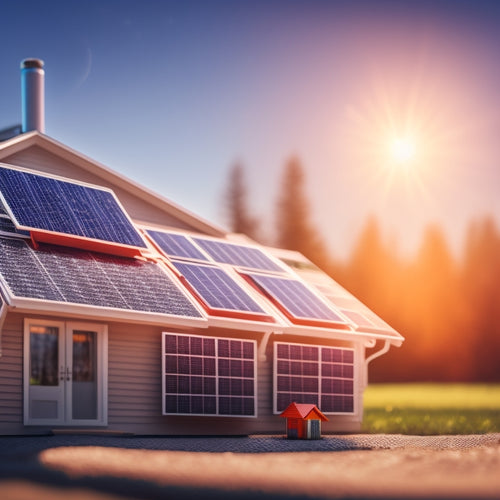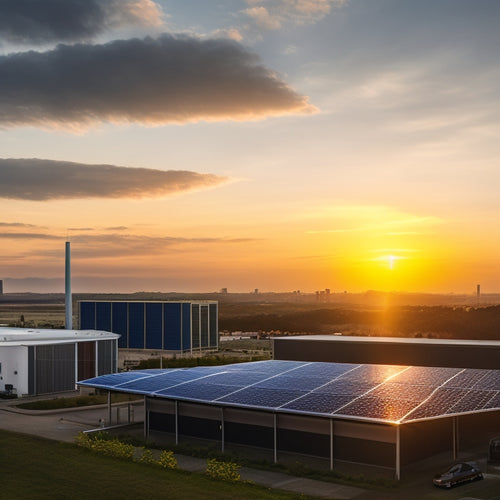
5 Best DIY Home Energy Kits Compared
Share
When comparing the 5 best DIY home energy kits, you'll want to take into account key factors like installation ease, power output, and efficiency. Look for kits with pre-wired and pre-assembled components, durable materials, and strong warranties. Evaluate power output in watts and efficiency ratings as a percentage to guarantee ideal energy generation. Choose compatible batteries and inverters from top brands like Tesla and SMA. Finally, analyze pricing and value by reflecting on upfront investment, long-term savings, and maintenance costs. By assessing these factors, you'll get closer to finding the perfect kit for your energy needs - and uncover the best options for a seamless shift to renewable energy.
Key Takeaways
- When comparing DIY home energy kits, consider the ease of installation, power output, and efficiency to ensure a reliable and cost-effective energy system.
- Evaluate the quality and durability of components, including solar panels, batteries, and inverters, to determine the kit's overall value and performance.
- Look for comprehensive installation instructions, online resources, and strong warranties to ensure a hassle-free setup and maintenance experience.
- Assess the environmental impact of each kit, including the materials used, recyclability, and carbon footprint, to make an eco-friendly choice.
- Compare the pricing and value of different kits by considering the upfront investment, potential long-term savings, and maintenance costs over time.
Top DIY Solar Panel Kits
With the cost of traditional energy sources on the rise, homeowners are turning to DIY solar panel kits as a cost-effective way to reduce their reliance on the grid.
Effective design guarantees reliability and efficiency in energy systems, and energy storage capacity and inverter efficiency are critical for seamless power supply off-grid energy systems.
When choosing a top DIY solar panel kit, you'll want to take into account kits that provide thorough installation tips and maintenance advice. Look for kits that include detailed instructions, videos, and online resources to guide you through the installation process.
Additionally, opt for kits with durable components and a strong warranty that covers maintenance and repairs.
Key Features to Consider
You'll need to carefully evaluate several key features when selecting a DIY solar panel kit to guarantee it meets your energy needs and budget.
Installation ease is vital, as it directly affects the overall cost and time required for setup. Many kits, such as Eco-Worthy and WindyNation, offer pre-wired and pre-assembled components simplifying installation, minimizing errors and setup time.
Look for kits with pre-drilled holes, simple wiring, and detailed instructions to guarantee a hassle-free installation process.
In addition, consider the environmental impact of the kit, including the materials used, recyclability, and carbon footprint. A kit with a lower environmental impact won't only benefit the planet but also increase your property's value.
Moreover, solar kits promote reduced reliance on fossil fuels and contribute to lowering carbon footprints through renewable energy generation.
Power Output and Efficiency
The DIY solar panel kit's power output and efficiency are vital factors to bear in mind, as they directly impact the amount of energy you can generate and the return on your investment. When evaluating a kit, you'll want to take into account the maximum power output, usually measured in watts (W), and the efficiency rating, typically expressed as a percentage.
| Kit Model | Maximum Power Output (W) | Efficiency Rating (%) |
|---|---|---|
| Kit A | 300 | 20.5 |
| Kit B | 400 | 21.2 |
| Kit C | 500 | 22.8 |
Understanding these performance metrics is fundamental for optimizing energy production and getting the most out of your DIY home energy kit. By evaluating power output and efficiency, you can make an informed decision and maximize your return on investment.
Battery and Inverter Options
Optimizing your DIY home energy kit's performance requires more than just a high-efficiency solar panel.
You also need to take into account the right battery and inverter options to guarantee a reliable and efficient energy supply.
When selecting a solar battery, it's vital to evaluate top-rated brands like Tesla and LG for reliability and durability.
When it comes to solar battery types, you'll want to choose between lead-acid, lithium-ion, or saltwater batteries. Each has its pros and cons, so it's important to research and select the one that best fits your needs.
Some popular inverter brands include:
- SMA
- Enphase
- Fronius
- Schneider Electric
Pricing and Value Analysis
Eight key factors influence the pricing of your DIY home energy kit: system size, component quality, installation costs, local incentives, maintenance requirements, warranty duration, scalability, and brand reputation.
When comparing costs, you'll want to reflect on not only the upfront investment but also long-term savings. A more expensive kit with high-quality components may provide better performance and longer lifespan, resulting in greater long-term savings.
Conduct a cost comparison of different kits, factoring in the costs of maintenance, repairs, and replacement parts over time. This will help you determine which kit offers the best value for your money.
Frequently Asked Questions
Can I Install a DIY Solar Panel Kit on My Own?
As you commence on utilizing solar power, you'll find that installing a DIY solar panel kit on your own is a challenging yet rewarding expedition, offering a sense of independence, while also reaping cost savings through a streamlined installation process.
Will a DIY Kit Work With My Existing Electrical System?
You'll need to verify the DIY kit's electrical compatibility with your existing system, checking installation requirements like voltage, amperage, and wiring configurations to confirm a safe and efficient connection that meets local electrical codes and regulations.
Are DIY Solar Panels Compatible With All Roof Types?
You'll find that DIY solar panels can work with most roof types, but you'll need to take into account roof material compatibility and potential installation challenges, such as asphalt shingle, metal, or clay tile roofs, which may require specialized mounting systems.
Can I Expand My DIY Solar Panel Kit in the Future?
While you're enjoying the benefits of your current DIY solar setup, you're likely wondering if you can scale up in the future. Fortunately, you can, as most kits offer future upgrades and expansion options, allowing you to adapt to your growing energy needs.
Do DIY Solar Panel Kits Come With Warranties or Guarantees?
You'll find that many DIY solar panel kits come with warranty coverage, typically ranging from 1-25 years, which often includes installation support, ensuring you're protected in case of defects or performance issues with your system.
Related Posts
-

Solar Phone Chargers for Camping Essentials
Solar phone chargers are must-haves for your camping essentials, allowing you to stay connected while enjoying nature...
-

A Beginner's Guide to Navigating the Solar Investment Tax Credit
You're eligible to claim a significant Solar Investment Tax Credit (ITC) of 30% of total installation costs, but mane...
-

Advantages of Commercial Solar Battery On-Site Storage
By investing in a commercial solar battery on-site storage system, you can greatly reduce your energy grid dependence...


